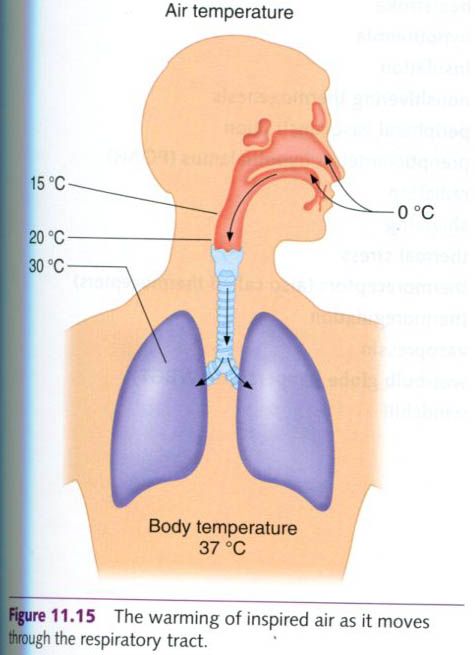Hypothermia
Individuals immersed in near-freezing water
will die within a few minutes when their rectal temperature decreases from a
normal level of 37°C(98.6°F) to 24 or 25°C(75.2 or 77°F). Cases of accidental
hypothermia, as well as data obtained from surgical patients who are
intentionally made hypothermic, reveal that the lethal lower limit of body
temperature is usually between 23 and 25°C(73.4-77°F), although patients have
recovered after having rectal temperatures below 18°C(64.4°F).
Once core temperature falls below about
34.5°C(94.1°F), the hypothalamus begins to lose its ability to regulate body
temperature. This ability is lost when the internal temperature decreases to
about 29.5°C(85.1°F). This loss of function is associated with slowing of
metabolic reactions to one-half their normal rates for each 10°C(18°F) decline
in cellular temperature. As a result, low core temperature can cause drowsiness
and even coma.
Cardiorespiratory effects
The hazards of excessive cold exposure include
potential injury to both peripheral tissues and the cardiovascular and respiratory
systems. Death from hypothermia has resulted from cardiac arrest while
respiration was still functional. Cooling primarily influences the sinoatrial node, the heart’s pacemaker,
leading to a gradual decrease in heart rate, and, ultimatively, cardiac arrest.
People have questioned whether rapid, deep
breathing of cold air can damage or freeze the respiratory tract. In fact, the
cold air that passes into the mouth and trachea is rapidly warmed, even when
the temperature of inhaled air is less than -25°C(-13°F). Even at this
temperature, when a person is at rest and breathing primarily through his or
her nose, the air is warmed to about 15°C(59°F) by the time it has traveled
about 5cm(2 in.) into the nasal passage. As shown in the figure below,
extremely cold air entering the nose is quite warm by the time it reaches the
back of the nasal passage, thereby posing no threat of damage to the throat,
trachea, or lungs. Mouth breathing, which often occurs during exercise, may
result in cold irritation to the mouth, pharynx, trachea, and even bronchi when
the air temperature is below -12°C(10°F). Excessive cold exposure also affects respiratory
function by decreasing respiratory rate and volume.
Treatment for hypothermia
Mild hypothermia can be treated by protecting
the affected person from the cold and providing dry clothing and warm
beverages. Moderate to severe cases of hypothermia require gentle handling to
avoid intiating a cardiac arrhythmia. This requires slowly rewarming the
victim. Severe cases of hypothermia require hospital facilities and medical
care. Recommendations to prevent cold exposure-related injuries were outlined
by the American College
Frostbite
Exposed skin can freeze when its temperature is
lowered just a few degrees below the freezing point(0°C,32°F). Because of the
warming influence of circulation and metabolic heat production, the
environmental air temperature(including windchill)
required to freeze exposed fingers; nose and ears is about -29°C(-20°F).
Peripheral vasoconstriction helps the
body retain heat. Unfortunately, during exposure to extreme cold, the
circulation in the skin can decrease to the point that the tissue dies from
lack of oxygen and nutrients. This is
commonly called frostbite. If not
treated early, frostbite injuries can be serious, leading to gangrene and loss
of tissue. Frostbitten parts should be left untreated until they can be thawed,
preferably in a hospital, without risk of refreezing.










0 коментара:
Постави коментар